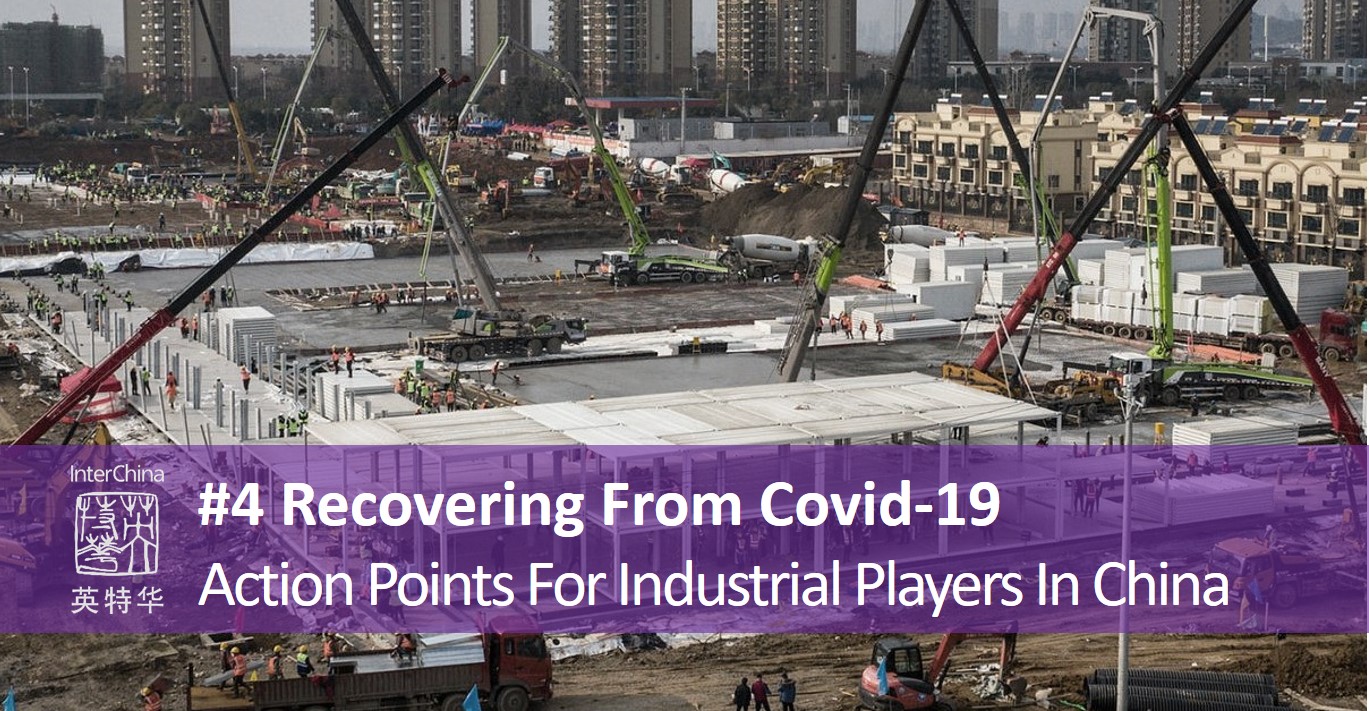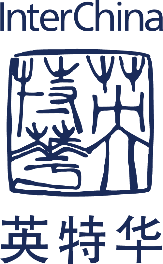
This is a blog series on how international companies in China should be responding in the wake of the ongoing Covid-19 crisis. Although the pandemic is continuing to cause huge disruption to the global economy, we are now seeing the beginnings of a recovery in China as it emerges out of the crisis. That makes it wise to start allocating at least some management bandwidth back to strategic planning and investment, especially as the business context in many sectors has been significantly reshaped. In this fourth post, InterChina’s partners Eduardo Morcillo, James Sinclair and Franc Kaiser look at what international companies in China’s industrial space should be planning.
May 15, 2020
The Covid-19 outbreak caused huge disruption to industry in China. Workers weren’t able to return to plants, factories were running well below capacity if at all, there was little in the way of logistics operations to move goods, and new investment was put on hold. Now that the outbreak has spread worldwide, weak export demand is inhibiting a full and immediate recovery.
The most affected industrial sectors have been those exposed to consumer demand and heavily reliant on labor. In the automotive sector, where demand had already been in decline for some time, there was a further 31% drop in sales during the first four months of 2020 compared with the same period last year. Soft demand will put further pressure on many carmakers given the general state of overcapacity across the sector, and could take years to return to recent levels. This has far reaching implications given China’s share of global auto production has risen from 7% in 2003 to 27% currently.
Nevertheless, despite the disruption, now is not the time for international industrial companies in China to lose their nerve. China’s economic fundamentals are robust, and with the recovery here now underway, there is actually much to plan and do. Indeed, as we proceed through 2020 and into 2021, the Chinese market should be seen as a source of lift when other markets are dragging.
Dealing with Disruption
Waiting It Out: There has been no proliferation in special price promotions thus far. Instead, industrial companies have been holding their breath in the hope, or expectation, that demand returns. Even if discounted prices or advantageous payment terms were offered, they wouldn’t have resulted in an uptick in sales.
Shift To Digital Marketing: Most industrial players are cutting back expenditure on marketing. Local trade shows and exhibitions have been canceled anyway, and sales teams will reduce travel for the foreseeable future. Instead, marketing activity is being channeled towards social media, webinars and the like. However, this will not compensate for the criticality of personal sales calls, and we will likely see a downsizing in sales force functions this year.
Remote Service: Reduced mobility has made the provision of service support across China very difficult. Industrial players have been informing their customers in which provinces and cities they are able to provide coverage, and in which ones not. Meanwhile, remote service models are being strengthened, including ramping up call center activity.
Holding Your Nerve
Strong Fundamentals:Compared with the SARS outbreak in 2002/2003, Covid-19 will cause more economic and business disruption in China. However, the difference now is that China’s economic fundamentals are more robust, and over the coming years industry in China will continue to grow, with much of this driven by endogenous forces. Industrial sectors will innovate and upgrade, as well as consolidate and rationalize, resulting in a mix of world-class leaders and high value-added specialists.
A Time To Act: There is thus opportunity for industrial companies to recover from business disrupted and lost. Indeed, the longer-term upshot of the outbreak should be more positive than negative for those who stay focused and pursue growth. Regardless of how grim it is at present, with challenges keeping businesses operational and solvent, it would be wise to start allocating at least some management bandwidth back to strategic planning and investment.
Make Or Break: For some smaller international companies in China’s industrial space, however, the outbreak will be too much to endure. We expect to see an increasing number stepping back from the market, laying off their sales forces, and handing their operations over to trusted dealers. For those that remain, this will make for a more consolidated competitive landscape, and less direct competition from international counterparts.
Planning For Recovery
Keep Sales Functions Motivated: Sales functions in China are primarily driven by KPIs. For companies where sales have dropped significantly, and sales functions lose hope of achieving their KPIs and securing their annual bonuses, there is a risk that motivation plummets and sales suffer even more than they have to. This risk needs to be addressed pre-emptively, adjusting targets downwards and tilting them towards higher potential products, or pushing back timelines for targets to be met.
Listen To Customers: In such volatile times, even with weak demand, industrial companies need to ensure they are still making the effort to listen to their customers and understand what they are thinking. The impact of the outbreak, in addition to the short-term disruption, will have a long-lasting legacy on certain elements of the economy. This could relate to changing consumer behavior and product demand, levels of factory automation, the location of supply chains, and much more. Engaging with customers during the outbreak may mean redesigning sales force KPIs, embracing digital channels in lieu of personal sales visits, or leaning on dealers to do more. Only then will industrial players know if the needs of their customers are changing.
Managing Dealer Risks: Dealers are under huge working capital pressure, and need to be well managed to avoiding them dumping inventory at low prices. For those industrial players that continue to be reliant on dealers, they need to look at relaxing their payment terms, and reducing the level of inventory their dealers hold. Other industrial players may look to reduce their reliance on dealers if their sales functions have reached critical mass, especially given the need to stay close to the market in these volatile times.
Align With Fiscal Stimulus: Of the policy levers available to the government, we are likely to see significant fiscal stimulus. This will span: (a) purchase subsidies or discounts on durable goods to stimulate consumption; (b) targeted support for certain industries, especially in healthcare, advanced industry, and communications networks; and (c) bringing forward existing infrastructure development plans, especially in the worst hit regions. International companies should stay close to policy developments, and be ready to align business activity with fiscal initiatives as and where relevant.
Buy On The Dip: We expect a strong period of M&A activity through the remainder of the year. The consolidation trend that was already underway in China will be accelerated by the outbreak. This will include good businesses that are suffering from short-term troubles, with more reasonable valuations that present attractive acquisition opportunities for international companies to pursue. Now is the time to develop an acquisition strategy, beef up your deal pipeline, and start to engage with potential targets.
Potential For Deregulation: In addition to a drop in economic growth, the outbreak will also put pressure on unemployment. As we saw during the Asian Financial Crisis, this may prompt Beijing to pull the deregulation and privatization levers. The most obvious sectors to benefit will be automotive, chemicals, construction, finance, healthcare and industrials. International companies in those sectors should monitor policy developments, and ready themselves for improved market access.
Conclusion
With the spread of Covid-19 worldwide, attention will turn to protecting home markets over the coming months. But as we have seen several times in recent decades, when global markets are soft, the Chinese market can provide a source of lift. Thus, as business activity resumes in China, international companies should be putting pressure on their China operations to pursue growth.
Next Time
In our next posting we look at how the machinery sector, and the provision of maintenance and repair services, is set to exemplify new business model opportunities in the wake of Covid-19. In another posting we will look at the consumer sector, while we round off the series by exploring the M&A opportunities that now lie ahead.
Blog Series
#1 Recovering From Covid-19: To ‘V’ or not to ‘V’
#2 Recovering From Covid-19: Lessons learnt from China
#3 Recovering From Covid-19: Action points for industrial players
#4 Recovering From Covid-19: Action points for retail and brands
#5 Recovering From Covid-19: The M&A opportunity (to be published)
#6 Recovering From Covid-19: Action points for retail and brands (to be published)
#7 Recovering From Covid-19: The M&A opportunity (to be published)

Author: Eduardo Morcillo, James Sinclair and Franc Kaiser
Follow Us for More Information


 English
English









